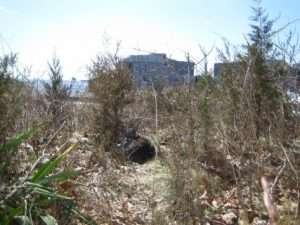

The recent release of Justice John Paul Stevens' papers have attracted new attention to the Supreme Court's controversial 2005 ruling in Kelo v. City of New London, the 5-4 decision in which the justices ruled that the condemnation of homes for "private economic development" is permissible under the Takings Clause of the Fifth Amendment, which only allows takings that are for a "public use." Notoriously, the development project that supposedly justified the condemnations fell through, and nothing was actually built on the property where the dispossessed owners' homes previously stood. Since the last homeowners were forced out and their houses torn down, the only regular users of the condemned land were a colony of feral cats.

That may now be in the process of changing. While I missed the news at the time, in January the Renaissance City Development Association (the private nonprofit development firm formerly known as the New London Development Corporation, which took ownership of the property after it was taken by eminent domain) sold the condemned land to a developer, which may plan to build new housing on it. The New London Day reported some details on January 19:
[A]ll the properties on the Fort Trumbull peninsula are slated for development.
Parcels on the peninsula, which also is home to Fort Trumbull State Park, have been vacant for almost 20 years. The land was cleared for development in a move by the city that led to the landmark 2005 U.S. Supreme Court decision, Kelo v. New London, about the use of eminent domain….
The land is owned and marketed by the city's development arm, the Renaissance City Development Association.
According to a development agreement between RCDA and RJ Development, parcels labeled 1A and 3C were sold for $500,000 and parcel 4A was sold for $1. The developer agreed to pay a $30,000 deposit to show its commitment.
The agreement states the projects on the property will primarily consist of, but will not be limited to, "the construction of residential units to be offered for market rate sale or rent/lease," with the associated parking and other improvements.
Parcels 3C (formerly part of a larger unit called Parcel 3) and 4A are the former sites of the residential properties condemned in the Kelo litigation. Susette Kelo's famous "little pink house," which became a nationally known symbol of the case, was on 4A.
A later story, published on February 3, provides some additional information, including that the low price of Parcel 4A was because of the "cost of remediating the remaining contamination of soil and groundwater." That contamination apparently developed during the long period when the parcel lay empty.
I have not been able to find any further information on what exactly RJ Development plans to build and when construction will be completed. The project is not listed on their website, which does however describe in detail another project they are doing in the area. I have contacted RJ Development to see if they are willing to provide any details. If I learn anything of interest, I will post it right here at the Volokh Conspiracy blog!
Since 2005, several efforts to redevelop the condemned land have fallen through. Hopefully, this one will succeed. But even if it does, I don't think it will somehow vindicate the Kelo condemnations. The new development initiative is obviously different from the badly misconceived plan that led to the use of eminent domain over twenty years ago. Moreover, by the time any construction is completed, the land will have lain unused (except by feral cats!) for nearly twenty years. From the standpoint of promoting development, that's an enormous waste.
The region would almost certainly have been better off economically if the original owners had been allowed to keep living there, paying property taxes, and contributing to the local economy. And that doesn't even consider the enormous pain and suffering the original development project inflicted on those who lost their homes (including some who sold them "voluntarily" as a result of harassment and the threat of eminent domain). I describe the history of the condemnation process and the harm it inflicted in much more detail in The Grasping Hand: Kelo v. City of New London and the Limits of Eminent Domain, my book about the Kelo case and its aftermath.
As I have previously emphasized in the book and elsewhere, the flaws in the New London development project don't necessarily prove that the Court got the Kelo decision wrong. Plenty of unjust and ill-conceived government policies are still legal. But there are in fact compelling reasons to reject the Court's reasoning, from the standpoint of both originalism and living constitutionalism. At least four current Supreme Court justices have expressed interest in revisiting and possibly overruling Kelo, and I hope it will indeed eventually be overruled. In the meantime, I will do what I can to find out what, if anything, is going to be built on the two parcels.
The post Will There Finally be Some Development on the Land Condemned in Kelo v. City of New London? appeared first on Reason.com.







